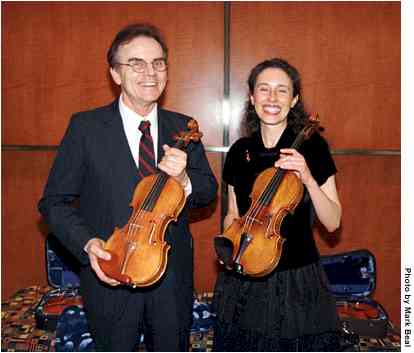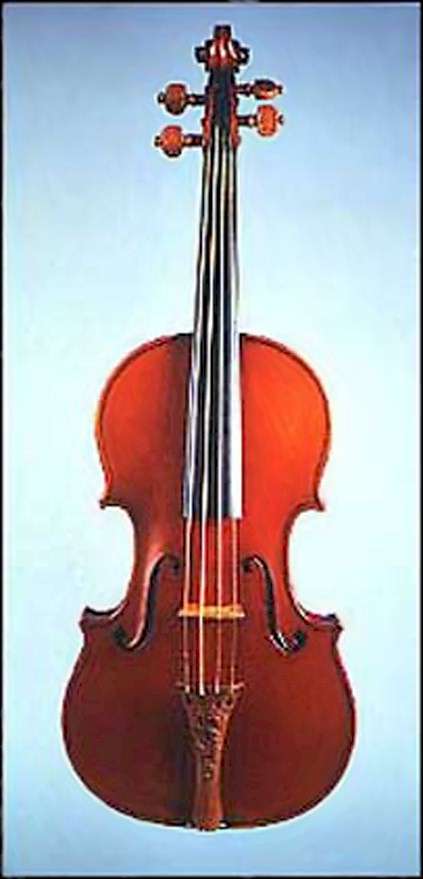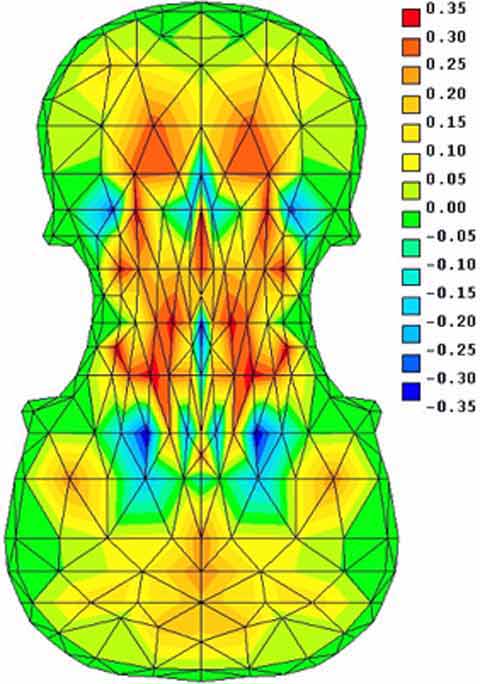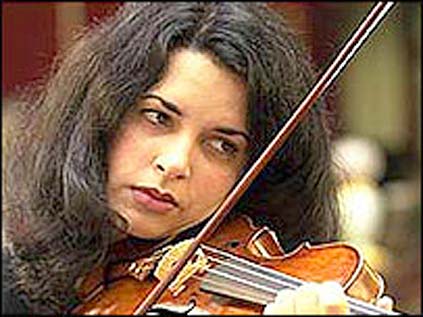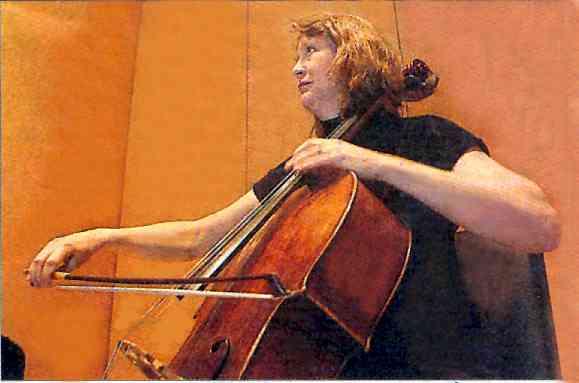The Secrets of Musical Sound
Fiddling Around the LabI inherited a painting and a violin which turned out to be a Rembrandt and a Stradivarius. - Tommy Cooper by Gregory Byrne If Joseph Nagyvary's boss finds him fiddling around on the job, he's not necessarily displeased. Nagyvary, a biochemist at the College of Agriculture of Texas A&M University, spends most of his time synthesising oligonucleotides and pondering the role of fibre in nutrition. But he also has an interest in the chemistry of violins, especially the fabled ones made in 18th-century Cremona, Italy, by Antonio Stradivari. Hungarian by birth, Nagyvary has had a lifelong love affair with the violin, and as a child dreamed of becoming a concert violinist. But the boy's violin, like most musical instruments, was confiscated by authorities during World War II, and Nagyvary turned his attention to science. Regarded as among the finest violins ever made, only about 600 Strads are thought to exist today. Nagyvary thinks their fine sound results from the chemistry of the wood and varnish used. Scanning electron micrographs he's taken of wood samples from 18th-century violins reveal remnants of fungi and bacteria that made the wood unusually permeable. He speculates that wood for northern Italian violin makers was cut and then transported downriver to Venice, where it remained in a lagoon until needed, soaking up the rich broth of microorganisms in the water. Micrographs he's taken of varnish specimens from instruments of that era reveal large quantities of finely ground minerals, which would have permeated the wood, improving the sound. (Nagyvary described his ideas in detail in the 23 May 1988 issue of Chemical & Engineering News. Nagyvary's theory is highly controversial, because for the past 150 years violin makers largely have used impermeable wood with a soft varnish-precisely the opposite of Stradivari's presumed process. But Nagyvary thinks his data are irrefutable and the 30 violins built and finished to his specifications, living proof. Ola Rudner, concertmaster of the Vienna Chamber Orchestra, recently played several Nagyvary violins. "I like them very, very much," Rudner said in an interview. "They have a beautiful big tone and a robust sound. I think they have great promise." The state of Texas seems to agree. The state legislature recently gave the chemist a $275,000 start-up grant for a new business that Nagyvary hopes will make Texas the violin-producing capital of the United States - a sort of 20th-century Cremona. Source: Science, Volume 241 22 July 1988
Decoding the Stradivarius
Professor Joseph Nagyvary (left) was honored Monday night at Texas A&M's George Bush Presidential Conference Center for his quarter century of work in studying the Stradivarius sound and making his own violins that rival the legendary musical instrument. He holds a "Nagyvarius" along side a "Stradivarius" held by Zina Schiff, who presented a recital at the special program entitled "Decoding the Stradivarius." Source: tamu.edu 13 February 2001 Nagyvary's very interesting website was located at nagyvaryviolins.com.
The Secret behind the Stradivarius SoundDallas - A biochemist says he has unravelled the secret behind the dazzling sound of Stradivarius violins - and it is not due to Stradivarius' extraordinary skill but chemicals, including ingredients now found in detergents, that were used to treat the wood. After years of research, Dr Joseph Nagyvary concluded that borax, now used in laundry detergent, and alum, used for pickling in ancient times, contributed to the sound of the much-sought-after violins, which sell for millions of dollars. According to the Dallas Morning News, the 66-year-old said the chemicals were prescribed by chemists for wood treatment, and not for the purpose of improving sound quality. To test his theory, Dr Nagyvary started using the centuries-old technique to make his own violins. He soaks the wood in preservatives and, after a professional carves the violin, it is again rubbed with the preservatives. Using this method, it takes about 1½ years to finish a violin. He was honoured for 25 years of research at a concert earlier this month, where renowned violinist Zina Schiff performed using a Stradivarius violin and one made by Dr Nagyvary. "It was for the audience to hear the two instruments and prove really how beautiful this new instrument sounds," Schiff told the newspaper. "And it certainly can equal the power and the beautiful sounds of the 300-year-old instrument. I don't think most of the people there had a clue." Source: pub6.ezboard.com from Straits Times
So You Think You May Have a Stradivarius?Before you do anything else, check out this site: si.edu/resource/faq/nmah/stradv.htm
Conversely: Stradivarius' Sound "Due to Sun"
"The Messiah": The sun's output may have been key to its qualities. by Dr David Whitehouse Reduced solar activity in the 17th Century may be the reason for the perfect sound of Stradivarius violins. Scientists from Columbia and Tennessee universities in the US say the sun's declining output at that time resulted in colder winters and cooler summers. This produced slower tree growth which in turn led to denser wood with superior acoustical properties - circumstances not repeated since. Today, musicians and collectors will pay many thousands for a Stradivarius. There is still considerable debate about why the violins made by Antonio Stradivari sound superior to modern-day violins. Born in 1644, he established his workshop in Cremona, Italy, and remained there until his death in 1737. During his lifetime, it is estimated he made 1,100 instruments - violins, guitars, violas, and cellos - of which about 600 survive today. Stradivari is responsible for crafting the most celebrated violin in the world: "The Messiah" in 1716. But what makes these instruments so prized? The popular belief is that the Cremonese artisans of the late 17th to 18th Centuries had a "secret ingredient" (or undocumented technique) that gave the instruments their famed sound. Candidates include the use of a special varnish, chemical treatment of the wood, "cooking" or drying the wood, wood seasoning, and the use of very old wood from historic structures. But two US scientists think the answer can be found in the sun. Stradivari was born one year after the start of the so-called Maunder Minimum - a period between 1645 and 1715 when our star went through a decline in activity and output. During this period, sunspots were rarely seen on the sun, and the 11-year solar cycle that is so prominent today was closed down. The Maunder Minimum coincides with what climatologists call the "Little Ice Age", a period of very cold weather in western Europe. Estimates of the cooling during this time range from 0.5 to 2 deg Celsius. Evidence for the cold spell is found in tree-ring records from high-elevation forests in the Alps. There was a long period of reduced growth rates, and when trees grow slowly their wood is denser. Writing in the journal Dendrochronologia Lloyd Burckle, of Columbia University, and Henri Grissino-Mayer, of the University of Tennessee, say that the long winters and cool summers of the period produced wood that gave the unique, rich sound of the Cremonese instruments. They point out that violin makers have always known that the selection of the wood makes all the difference to the sound of the instrument. Maple is preferred for the back, ribs, and neck, while spruce is preferred for the top. Stradivari and other eminent Italian violin makers of the 17th and early 18th Century who worked in Cremona probably used the nearby forests of the southern Italian Alps as their source of spruce wood. It seems that the trees growing during the lifetime of Stradivari experienced a unique set of environmental conditions that has not occurred since. Source: news.bbc.co.uk Wednesday 17 December 2003
Scientists at Mid Sweden University Dispel the Mystery Surrounding Stradivarius Violins
Antonius Stradivarius violins are shrouded in more myths than any other instruments in world history. At Mid Sweden University, researchers are using modern technology to uncover his secrets. At the international acoustics conference which just took place in Lisbon in July 2005, Associate Professor Mats Tinnsten presented the latest research findings in the field. "It's not possible to copy Stradivarius violins exactly, since wood is a living material with great natural variations. The results of new research indicate, however, that we will be able to overcome such difficulties with the aid of advanced computer support," says Mats Tinnsten. The Italian Antonius Stradivarius, 1644 - 1737, introduced a geometry and design that became the exemplar for all violin-makers. Of the 1,100 instruments he built, some 650 still survive. The extremely high value of these instruments was demonstrated at an auction at Christie's in London in April. The "Lady Tennant" Stradivarius violin sold for more than SEK 14 million, the auction record for a musical instrument. "His craftsmanship is still unexcelled. Few after the death of Stradivarius have managed to produce anything that even approaches his best work," says Mats Tinnsten, who, together with Associate Professor Peter Carlsson, is researching whether it is possible to copy Stradivarius violins with the aid of modern technology and powerful computers. What the Mid Sweden University scientists are trying to create is a violin with the same acoustic properties as a Stradivarius instrument. This work is progressing in stages, and it was decided that the first stage would involve calculations based on the top of the violin. "With the help of advanced mathematical optimisation method, we can determine how a top should be shaped to achieve the same properties as a top from a genuine Stradivarius," says Peter Carlsson. The reason it is not possible to simply copy a top or an entire violin exactly is that it can never be assumed that the new top will have the same material properties as the old one. During the 12th International Congress on Sound and Vibration, ICSV12 at the Lisbon University of Technology, Mats Tinnsten showed how far along he and Peter Carlsson have progressed in their pursuit of the perfect violin. "Stradivarius violins were made of slow-growth spruce. Perhaps our research will help create a new instrument-making industry in northern Sweden," concludes Peter Carlsson. For more information: Lars Aronsson, information officer Lars.Aronsson@miun.se Mid Sweden University Source: eurekalert.org 8 July 2005
Stradivarius Sells for £767,200
About 650 of Stradivari's instruments remain in the world today. A Stradivarius violin has sold at auction at Sotheby's, London, for more than £767,200. A 1736 cello also made by the master craftsman was also put up for auction but failed to sell. The violin's hammer price was £680,000 but the figure increased after VAT and auctioneers fees. About 650 of the prized Stradivari instruments still exist today and the world record price for one of his violins is £947,500. On Monday a 1700 Stradivarius violin valued at £600,000 failed to sell at Bonhams. The Bonhams violin was believed to be The Petri violin, named after Professor Henri Willem Petri, a famous Dutch violinist who once owned the instrument. It had remained in the same family for three generations, and arrived at Bonhams from a family collection in Europe. A 1736 cello also made by the master craftsman was also put up for auction but failed to sell. The violin's hammer price was £680,000 but the figure increased after VAT and auctioneers fees. Source: news.bbc.co.uk Tuesday 11 November 2003
Rare Violin Fetches £608,750A rare Stradivarius violin, thought never to have been played in a public concert, has sold for £608,750 at auction in London. The final amount was less than the £650,000 to £850,000 predicted sale price, but a spokesman said Christie's was "delighted" with the outcome of Wednesday's sale. The identity of the buyer was not disclosed but was described as a "private collector" who attended the event in person. The world record auction price paid for a Stradivari violin was £947,500 for The Kreutzer at Christie's in April 1998. Antonio Stradivari is considered the most distinguished violin maker in the history of the instrument. This 1726 example of his work was the highlight of the Christie's bi-annual musical instrument sale. There are thought to be only 500 remaining examples of Stradivari's skills and the Christie's violin was made when he was 82 years old. The violin, labelled Antonius Stradivarius Cremonensis, Faciebat Anno 1726 AS, had had several owners before Wednesday. It was once owned by Jean-Baptiste Vuillaume, one of the greatest French violin makers and foremost dealers of the 19th Century. The instrument was then acquired by the distinguished violin collector, David Laurie of Glasgow. In 1885, Laurie sold it to William Ebsworth Hill, a specialist violin restorer and an authority on string instruments. The violin then passed through the hands of various private collectors, including James H Cecil Hozier MP, a prominent Mason. Stradivari was born in Cremona, Italy, in 1644 and began his career in 1660, as a pupil of Nicolò Amati, and continued producing instruments until his death in 1737. During the 18th Century, Stradivari's unrivalled reputation for excellence extended throughout Europe. His instruments were coveted by royalty, noblemen and church dignitaries, as well as the most renowned musicians. Stradivari's later works are said to be some of his most powerful sounding instruments and the most coveted by musicians. Despite advances in modern technology, many concert violinists feel instruments created by 17th Century Italian masters like Stradivari have the better sound. Source: news.bbc.co.uk Wednesday 13 November 2002
Violin Fetches Record $3.5 Million at AuctionNew York - An anonymous bidder paid $3.54 million for a Stradivarius violin made in 1707 at auction house Christie's on Tuesday, making it the most expensive musical instrument ever sold at auction, Christie's said. The violin, known as the Hammer, was made by Antonio Stradivari in Cremona, Italy, during his "golden period," when he is believed to have crafted his finest instruments. Before the sale, Christie's had estimated the Hammer's value at $1.5 million to $2.5 million. The previous record belonged to the Lady Tennant, a 1699 Stradivarius that sold for $2.03 million at Christie's in April last year. Private sales have exceeded that price. Of the more than 1,100 instruments Stradivari is believed to have made, only about 620 violins survive today, according to Kerry Keane, head of the musical instrument department at Christie's. Source: Reuters 16 May 2006
Stradivari facts
Songs from Alaska's Spruceby Carla Helfferich This article is provided as a public service by the Geophysical Institute, University of Alaska Fairbanks, in cooperation with the UAF research community. Carla Helfferich is a science writer at the Institute. Let me offer a trick question: Why should management of the Tongass and Chugach national forests be of great interest to violinists? The straight answer is that the kind of trees growing in those Alaska forests, and the way they're treated once cut, offer a chance to recreate the wonderful sound of the world's greatest musical instruments. They offer part of what chance we have, anyway - or so says a knowledgeable Texan. (At least he works in that state, at Texas A & M; since his name is Joseph Nagyvary, I suspect he doesn't answer to "Bubba" or "Tex.") The roots of the tale reach far back, to 17th century Italy. The town of Cremona became a center of the violin-maker's craft like nothing seen before or since. A few families became known for their masterpieces in wood: Amati, Guarneri, Stradivari have been names associated with the most coveted stringed instruments for nearly 3 centuries. Despite prodigious efforts, and some magnificent also-rans, no violin makers since have been able to equal the products of the masters of Cremona. Such a long-standing puzzle naturally attracted scientists. What human wit could accomplish once, human wisdom surely could accomplish again - if the wisdom was furnished with enough information. Joseph Nagyvary turned aside from a career in biochemistry to gather that missing knowledge. Some details are widely known. Only certain types of wood can be used in good violins; for proper resonance, backs are maple, tops are spruce. The wood must be carefully selected - for example, the spruce must have a compact, even, and fine grain. It's in the other details that the mystery lies. Simply dried as if it were construction material, raw wood has dreadful acoustical properties. It's full of internal tensions and dried sap. It's too stiff for good tone, and violins made from it produce harsh, shrill notes. So all violin makers agree that the wood must be made to relax somehow, but they differ on how it's to be treated to get that proper degree of relaxation. They anoint it with chemicals, they boil it, they set it in smokehouses above piles of smoldering manure. The masters of Cremona left no record of which treatment they used. If, indeed, they used any. From a combination of historical reconstruction and micro- scopic examination of minute samples of classic violins wheedled from the world's best instrument restorers, Nagyvary has come to suspect that nature provided the crucial treatment for the Cremonese wood. First, history: trees destined to become famous violins were cut in the Alps. The green logs reached Cremona after long river voyages, and perhaps after long waits in rafted storage at sea. Second, science: Nagyvary knew that long soaking should encourage the growth of microorganisms in the sodden wood. The scanning electron microscope confirmed it. The precious fragments of Cremonese violins contained bacteria-caused holes in the wood's cell walls and tiny bits of fungal threads - some still growing. Microbial enzymes had increased the permeability of the wood fifty-fold, without decreasing its strength. It was full of myriad tiny additional air chambers to increase its resonance. In short, Stradivarius and his colleagues used rotten wood - just slightly, exactly, rotten-enough wood. And the salt concentration in the old wood was 10 to 50 times higher than any Nagyvary found in wood not exposed to seawater. Think now of Alaska coastal spruce, tossed fresh-cut into the sea and left to leach its sap into the ocean. It may wait a long time, long enough for microorganisms to begin their rotten work. It's just the right treatment. Nagyvary suspects if he does recreate the superb sound of a Stradivarius, it will be with the help of wood that once grew on Alaska's coast. Source: gi.alaska.edu 24 October 1990
Curiously, not all musicians know (or believe?) that the "secret behind the Stradivarius sound" has been discovered... (Perhaps some don't WANT to know - like current owners of Stradivarius instruments?)
There's a Reason It Sounds Like a Million Bucks
Star-Ledger writer Kathleen O'Brien plays the $2.8 million "ex-Prince Gursky Cello" by Kathleen O'Brien How does a Stradivarius cello differ from a regular cello? Think of a kitty-cat purring. Now think of a lion purring. Both are cats, both are purrs, yet one is ordinary and the other simply unforgettable. I had the chance to play a Stradivarius during an interview with Jonathan Spitz, principal cellist of the New Jersey Symphony Orchestra. The orchestra has on loan a dozen of the Italian instruments it may buy from arts patron Herbert Axelrod, who has offered to sell them at the half-price tab of $25 million. Until now, I've accepted that I'll always be the kind of amateur musician about whom they say, "Don't quit your day job." I play my cello with a community orchestra to great personal enjoyment but am fully aware of my limits. That was before - before I played the Strad. Now I'm ready to bag work and start buying lottery tickets. It goes without saying that Spitz sounds like a million bucks playing the Strad, but he hardly sounds like a two-bit player on his own 100-year-old cello. A better test would be someone like me. Is a Stradivarius so special that it could make even me sound better? Oh, most definitely yes. The most noticeable difference is the sheer amount of sound that bellows forth from it. I gingerly bowed an open string and reeled back in surprise at the volume I produced. Whoa, this baby's a boomer. The lowest notes are especially resonant: dig into the low E, and a tsunami of sound washes over everyone within earshot. These deep pitches rumble so vibrantly I could feel them in my chest. Stradivarius instruments, along with their counterparts from Cremona, are held in awe some 300 years after their creation, the source of their unduplicated sound still a mystery. Only the top professional players - mostly concert soloists - get the chance to play them. I came to the orchestra's concert last Thursday dressed to play, just in case the opportunity arose. I chose my wardrobe with the 1696 instrument's protection in mind: no buttons, bracelet, necklace or earrings - nothing that could possibly scrape, scratch, dent or ding its 300-year-old veneer. After all, this is a cello so famous and rare it has its own name: the "ex-Prince Gursky Cello." The title pays homage to the czarist prince who fled the Russian Revolution in 1922 with the cello disassembled and its parts smuggled out in his baggage. Damage it and the act would be instantly notorious, written up in the instrument's appraisal. I spent the day in dread of creating "The Star-Ledger Ding" in the "ex-Prince Gursky Cello." (I intentionally avoided discovering the instrument's worth before my encounter; I was nervous enough already.) Given the instrument's age - Peter the Great was attacking the Turks the year it was made - I had expected it would require tender treatment. What surprised me was its strength. Spitz says he gives it a real workout during concerts, and it can take whatever he demands of it. Before I played it, I thought of the Stradivarius as fragile and delicate, and my cello at home as sturdy and solid. Now I think the reverse. Bow my cello - purchased for me by my parents for $350 when I was in 9th grade, and now worth 10 times that - and the sound emerges immediately. Bow a little harder and you'll get more sound, but only up to a point. To get a decent sound out of the Stradivarius, however, you really have to lean into it. Spitz says he uses twice as much rosin on his bow for the Strad in order to get the strings fully vibrating. Once this cello gets going, though, it appears to have an almost bottomless pit of sound to be explored. Yet its real glory comes when one plays softly. "It's fantastic," Spitz said. "That's the best." It takes strength to play this surprisingly durable and robust antique. If I owned a Strad, honestly, I would spend more time at the gym lifting weights in order to do it justice. If I owned a Strad ...what a magical phrase to contemplate. Alas, there remains the inescapable fact that if I owned a Strad, I would still be an amateur cellist with a bow arm as inflexible as the Tin Man's. Although I may sound better on the Strad, it is not because it renders me a better player. You could borrow Tiger Woods' golf clubs, and you still wouldn't play like Tiger Woods. The flip side is true as well: Tiger Woods could win the Masters using clubs he picked up at a garage sale. Or as the orchestra's outgoing music director, Zdenek Macal, puts it, he'd rather have a great pianist playing a good piano than a good pianist playing a great piano. The New Jersey Symphony Orchestra is hoping its fund-raising drive to own this unprecedented cache of nearly priceless instruments will put greatness in the hands of greatness. Having safely completed my interview without incident, the next day I braced myself to inquire about the ex-Prince Gursky's appraised value. The answer: $2.8 million. Urn, could you hand me those smelling salts? I feel faint. Source: The Sunday Star Ledger 19 May 2002 photo credit Julie Pena
How Do You Make a Better Violin?by Nigel Bunce and Jim Hunt In the Renaissance, two families of bowed stringed instruments developed out of earlier forms such as the "rebec". These were the "viols" and later the "violins". Because of their richer, louder sound, the violins have prevailed and the viols have disappeared except for the contrabass viol, the lowest pitched stringed instrument in the modern orchestra. The inventor of the violin is unknown but it may have been Andrea Amati who founded a great school of violin makers in Cremona in Italy about 1560. For the next 150 years, the Amati family and their pupils, Guarneri and Stradivari, brought the art of violin making to a peak of achievement which has never been surpassed and only now may perhaps be approached. The greatest instruments were made in only a few decades by Antonio Stradivarius (1644 - 1737) and Giuseppe Guarnerius (1638- 1745). With the death of these two, the Cremona school virtually disappeared and with it the secrets of making the finest violins. In the intervening 250 years, the surviving instruments have been searched out, lovingly maintained and increased vastly in price. The value has increased to such an extent that there is now a deplorable tendency for institutions to buy them as valuable investments and thus remove them from the hands of performers. Naturally, violin makers would like to know the secret so that modern instruments could rival and even surpass the Cremona violins. Many artisans have announced at various times that they have discovered the secret. First, it was the wood: obviously, the wood and its curing are important but try as they might no manufacturers have duplicated the great instruments by a combination of wood and cure. About 50 years ago, it was announced that the secret was in the varnish that was used to finish the instrument but this suggestion also proved not to be the correct one. Increasingly after the Second World War, physicists, chemists and engineers have claimed that the problem was like any other and could be solved by the methods of scientific research. Although much has been learned, progress has been slow and the effort might also be considered a failure since science has still not told us how to make a Stradivarius. It has been learned that the shaping of the back of the violin is important. The Stradivari have backs of varying thickness and the region of thickest wood is strategically placed off-centre. Still, this is not really a new result; a world-famous modern viola maker in Toronto has known this for years and constructs his violas accordingly. He learned it as all great artisans do - by trial and error. The latest scientist to enter the fray is Dr J Nagyvary, a biochemist at Texas A and M University. He believes that the secret is one unknown to Stradivarius himself; it a slimy fungus that grew on the wood he used. He claims that the Cremona school had their wood cut in the winter and floated along the waterways to the lumber mills downstream to be cut and dried in the spring. The period in the water promoted the growth of fungi which released enzymes which destroyed a gummy material in the wood called hemicellulose. The result, when finally dried, was a lighter and drier wood. The art of violin making passed from Cremona to Germany where the spruce and maple was dried in the cold winter air. In this process, the fungi could not form and the hemicellulose was not removed. Modern violin making descends from the German practice. Along with the other "secrets" that science has revealed, this one may also be relevant but the world still awaits the production of a modern violin which equals or surpasses the best produced by the Cremonese. College of Physical Science Source: physics.uoguelph.ca The Science Corner 7 October 1987
-------- Original Message -------- Hi About the article of the progressing work in reshaping the arch shape of the Strad violin. There's a difference in acoustical and mechanical function of the arch shape and condition!! Take a look at my site. Kind regards See also:
For articles on poverty, social markets, superfluous children, isolation, modern mating difficulties, status, boasting, gender differences, patriarchy, capitalists, civility,
groups, racism, virtue, ethics, art, music, religion and crewing click the "Up" button below to take you to the
Index page for this Social/Cultural section. |
 Animals
Animals Animation
Animation Art of Playing Cards
Art of Playing Cards Drugs
Drugs Education
Education Environment
Environment Flying
Flying History
History Humour
Humour Immigration
Immigration Info/Tech
Info/Tech Intellectual/Entertaining
Intellectual/Entertaining Lifestyles
Lifestyles Men
Men Money/Politics/Law
Money/Politics/Law New Jersey
New Jersey Odds and Oddities
Odds and Oddities Older & Under
Older & Under Photography
Photography Prisons
Prisons Relationships
Relationships Science
Science Social/Cultural
Social/Cultural Terrorism
Terrorism Wellington
Wellington Working
Working Zero Return Investment
Zero Return Investment